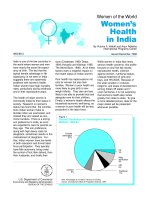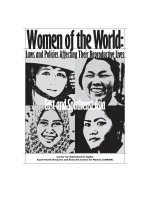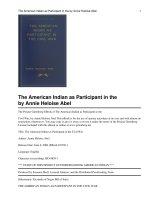5 9 women of the civil war
Bạn đang xem bản rút gọn của tài liệu. Xem và tải ngay bản đầy đủ của tài liệu tại đây (2.58 MB, 10 trang )
WOMEN
Fascinating Facts
• Clara Barton discovered that a soldier she was treating
was a woman. Barton helped the woman get back
together with her husband. The couple named their
daughter after Clara Barton.
of the
CIVIL WAR
• Because she became ill, Harriet Tubman was unable to
join John Brown in his raid on Harper’s Ferry.
• When Confederate spy Belle Boyd was returning
from Europe, her ship was captured by the Union
navy. She fell in love with a Union naval officer and
married him.
Genre
Nonfiction
Comprehension Skill
Main Ideas and
Details
Text Features
• Captions
• Sidebar
Scott Foresman Social Studies
ISBN 0-328-14900-4
ì<(sk$m)=beja b< +^-Ä-U-Ä-U
by Joan Nichols
The Civil War was a difficult war that cost the labor and
resources of Americans in the North and the South. What
did women do in the war? In this book you will read
about some of the brave women who lived during the
Civil War.
Vocabulary
Write to It!
WOMEN
Most women who lived during the Civil War could
not fight in the war, but many women found a way
to take part in it. Write one or two paragraphs about
one of the women discussed in this book. Explain
why you think her efforts made a difference.
of the
CIVIL WAR
Write your explanation on a separate sheet of paper.
secede
draft
regiment
courier
Photographs
Every effort has been made to secure permission and provide appropriate credit for photographic material.
The publisher deeply regrets any omission and pledges to correct errors called to its attention in subsequent editions.
by Joan Nichols
Unless otherwise acknowledged, all photographs are the property of Scott Foresman, a division of Pearson Education.
Photo locators denoted as follows: Top (T), Center (C), Bottom (B), Left (L), Right (R), Background (Bkgd).
ISBN: 0-328-14900-4
Copyright © Pearson Education, Inc. All Rights Reserved. Printed in the
United States of America. This publication or parts thereof, may be used with appropriate
equipment to reproduce copies for classroom use only.
1 2 3 4 5 6 7 8 9 10 V0G1 14 13 12 11 10 09 08 07 06 05
Opener: (C1) Library of Congress, (C2) ©Getty Images
2 North Wind Picture Archives
3 North Wind Picture Archives
4 Hulton-Deutsch Collection/Corbis
5 The Granger Collection, New York
6 Library of Congress
8 (C) Library of Congress,Editorial
(T) The Granger
Collection,
NY, (B)Illinois
Corbis • Parsippany, New Jersey • New York, New York
Offices:
Glenview,
10 Duke University, Rare Books, Manuscript & Special Collections Library
11 The Granger Collection,Sales
NY Offices: Needham, Massachusetts • Duluth, Georgia • Glenview, Illinois
12 ©Bettmann/Corbis Coppell, Texas • Sacramento, California • Mesa, Arizona
13 ©Bettmann/Corbis
14 The Granger Collection, NY
The Abolitionists
Some women were abolitionists before the Civil War
even began. They wrote against slavery and spoke out
in public speeches.
Sarah and Angelina Grimke were abolitionists who
came from a family of wealthy slave owners in South
Carolina. Yet they always believed all people were
created equal.
Angelina Grimke was Sarah’s younger sister.
Even as a child,
Sarah Grimke
hated slavery.
2
The Grimke sisters moved to the North and spoke
out against slavery. The sisters were criticized by
many people who believed that women should not
give speeches in public. Other people admired these
former slave owners who spoke out so strongly against
slavery.
Sojourner Truth was born an enslaved person. She
was tall, intelligent, and had a strong voice. When
she spoke about her own experience at anti-slavery
meetings, listeners were drawn to her powerful
speaking.
3
The Woman Behind the Song
You may have heard the song that begins,
“Mine eyes have seen the glory.” Julia Ward
Howe wrote it after she had heard some Union
soldiers singing a popular marching song called
“John Brown’s Body.” The next day she wrote new
words for the song and sent them to The Atlantic
Monthly magazine. Soon “The Battle Hymn of the
Republic” was sung all over the North.
When President Abraham Lincoln met Harriet Beecher
Stowe, he supposedly said, “So you’re the little woman
who wrote the book that started this Great War!”
Two Harriets
Harriet Beecher Stowe was born in 1811 in
Connecticut, which was a free state. In 1832 she
moved to Ohio, which was also a free state at that
time. Here Stowe learned about slavery and enslaved
people who escaped to freedom.
She heard about a young African American woman
who carried her baby across the river when it was
covered with ice. Stowe used this story when she
wrote Uncle Tom’s Cabin. Her book made readers see
enslaved people as fellow human beings.
4
Most abolitionists spoke in public
and wrote books to fight slavery.
Harriet Tubman risked her own
life and freedom to help enslaved
people escape. She traveled south
eighteen times, leading people
north to freedom. Slave owners
offered a large reward for her
capture, but she was never caught.
Harriet Tubman, who was born
an enslaved person, escaped in
1849. She was so thrilled to reach
free ground, she said, “I looked at
my hands to see if I were the same
person.”
The War at Home
Nurses
After the South seceded from the Union in 1861,
the fighting started. Women worked hard and acted
with courage defending their homes and supporting the
cause in which they believed.
Because most men in the North and South joined
the army or were called up by the draft, women had
to run the farms and businesses. Times were hard and
there was a lack of food and clothing, especially in
the South. Poor women went to work to support their
families. Women also sent the soldiers blankets, sheets,
towels, and food.
More than two thousand women served as nurses
during the Civil War. Ellon McCormick Looby and her
four-year-old son traveled from New York to Virginia to
nurse her husband. She continued serving as a nurse in
the same hospital until the war ended.
Clara Barton
Clara Barton decided to ask people to send her food
and medical supplies for Union soldiers. Friends helped
her deliver them to the battlefields. She also helped find
missing soldiers and helped their families contact them.
Later she founded the American Red Cross.
Sally Louisa Tompkins
Sally Louisa Tompkins opened a hospital in a friend’s
house in Richmond, Virginia. She used her own money
to run it. Because the wounded soldiers got better, the
army made her a captain. From then on she was called
“Captain Sally.”
During the Civil War, nurses often worked
with army officers.
6
7
Laundress, Teacher, Nurse
Louisa May Alcott
Susie King Taylor was born an enslaved person, but
she learned how to read and write. When she was
fourteen, she was freed by Union troops before slavery
ended. She married Sergeant Edward King, a member
of the 33rd United States Colored Troops. The 33rd
was a regiment of former slaves.
Taylor lived with the regiment. She taught the soldiers
how to read and write. She nursed the wounded and
continued working as a nurse for the next four years.
Woman Doctor in the War
Susie King Taylor
Mary Edwards Walker
Dr. Mary Edwards Walker was the first woman
doctor to serve in the Union army. She was later
appointed as a medical officer. She was captured by
the Confederates in 1864 and spent four months in
prison. After the war she was given the Congressional
Medal of Honor, the country’s highest military award.
She was the first woman ever to receive it.
A Writer and Nurse
The book Little Women takes place during the Civil
War. Louisa May Alcott wrote it. In 1862 she went
to Washington, D.C., to help take care of wounded
soldiers. A month later Alcott got sick and had to return
home. She wrote about her experiences in a book
called Hospital Sketches.
8
9
Spies
Some women became spies for the North or for the
South. They found out the enemy’s important secrets
and told these secrets to leaders on their own side.
Some women were couriers, or people who carried
messages across enemy lines.
Rose O’Neal Greenhow
Rose O’Neal Greenhow had many important
friends in Washington, D.C., so she was able to get
information from them secretly. She then told the
Confederate army what information she learned.
Elizabeth Van Lew
Elizabeth Van Lew
Rose O’Neal Greenhow
10
Elizabeth Van Lew was a Southerner who spied
for the North. She pretended to bring gifts to Union
prisoners in Richmond, Virginia. Actually, the prisoners
gave her information. They sometimes used a code
she invented.
11
Sarah Emma Edmonds served in the Union army as “Franklin
Thompson.”
Soldiers
At least four hundred women dressed as men and
joined the armies of the North and the South. Some
joined to be with their husbands or brothers. Many
served because they strongly believed in their side’s
cause. Others went just for the adventure. Most of
these women soldiers were found out only when they
became ill or wounded.
12
Loreta Velazquez served in the Confederate army
as “Lt. Harry T. Buford.” She wore a false beard
and mustache.
13
Teachers
Charlotte Forten
When Union soldiers entered the South, enslaved
people followed them. Besides wanting to be free, the
enslaved people also needed food, shelter, jobs, and
medical care. They also wanted to learn. Northern men
and women came south to help them, and many of the
women became teachers.
Charlotte Forten, a free African American, had a
good education and joined the abolitionist movement.
She became a teacher and wanted to help enslaved
people. She taught on St. Helena Island, South
Carolina.
This picture shows a school
in Vicksburg, Mississippi, for
former enslaved people.
14
15
The CivilGlossary
War was a difficult war that cost the labor and
resources
of Americans
in the North and the South. What
courier
a messenger
did women do in the war? In this book you will read
draftof athe
law
that women
requires who
men lived
of a certain
about some
brave
during the
age
to
serve
in
the
military,
if
called
Civil War.
regiment an army group with a large
number of soldiers
Vocabulary
Write to It!
Most women who lived during the Civil War could
not fight in the war, but many women found a way
to take part in it. Write one or two paragraphs about
one of the women discussed in this book. Explain
why you think her efforts made a difference.
Write your explanation on a separate sheet of paper.
secede to break away from a group, as the
Southern states secede
broke away from the United
States
draft
regiment
courier
Photographs
Every effort has been made to secure permission and provide appropriate credit for photographic material.
The publisher deeply regrets any omission and pledges to correct errors called to its attention in subsequent editions.
Unless otherwise acknowledged, all photographs are the property of Scott Foresman, a division of Pearson Education.
Photo locators denoted as follows: Top (T), Center (C), Bottom (B), Left (L), Right (R), Background (Bkgd).
ISBN: 0-328-14900-4
Copyright © Pearson Education, Inc. All Rights Reserved. Printed in the
United States of America. This publication or parts thereof, may be used with appropriate
equipment to reproduce copies for classroom use only.
1 2 3 4 5 6 7 8 9 10 V0G1 14 13 12 11 10 09 08 07 06 05
16
Opener: (C1) Library of Congress, (C2) ©Getty Images
2 North Wind Picture Archives
3 North Wind Picture Archives
4 Hulton-Deutsch Collection/Corbis
5 The Granger Collection, New York
6 Library of Congress
8 (C) Library of Congress, (T) The Granger Collection, NY, (B) Corbis
10 Duke University, Rare Books, Manuscript & Special Collections Library
11 The Granger Collection, NY
12 ©Bettmann/Corbis
13 ©Bettmann/Corbis
14 The Granger Collection, NY









